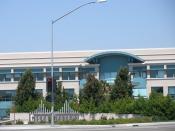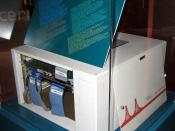When referring to computer science the purest mean of the phrase 'Denial of Service' was as it sounds, denying service or access to those were not authorized. Today Denial of Service takes on a whole new meaning instead of keeping computer secure it's a tool used to cause destruction. DoS (Denial of Service) is an attack in which an internet resource, network, or computer is rendered useless. This attack is accomplished by sending an unmanageable amount of data that causes systems to overload and sometimes crash. The targeted system could be anything from a singular computer(although not a very useful attack), to IRC servers, email services, or websites. The from or method of the attack can vary as a DoS attack is not particular, but the result is always the same. The victim is slowed down, some might say artificially, and the resource is then either completely unavailable or lacking the speed to accomplish anything in a reasonable amount of time.
The following are the more common ways in which a system is slowed or stopped(Wikepedia Encyclopedia):
1. Consumption of computational resources, such as bandwidth, disk space, or CPU time
2. Disruption of configuration information, such as routing information
3. Disruption of physical network components
The DoS attack is most often directed to servers which are flooded with useless traffic which then brings the entire network to it's knees. Like viruses there are security fixes that are created to protect against the attacks but as new security measures come out, just like viruses, new DoS attacks are developed. As servers have rapidly grown in size and ability the attacks have had to grow as well. The result is Distributed Denial of Service attacks or DDoS. Some common forms of DoS attacks are:
1. Buffer Overflow
2. SYN
3. Teardrop
4. Smurf
5. Viruses
6. Physical Infrastructure
The following figure is a visual representation of a DDoS attack. The Client computer is used by the person directing the attack. Using their computer they use programs on the Handler systems. These Handlers are then capable of controlling multiple other computers or agents. The Agent is a host that has been broken into and used without permission. By running a special program on each of the Agents the attacker then generates streams of packets on each Agent and directs these packets to the intended victim, thereby overloading the victim with useless data.
The following steps are the process that the attacker must go through(Cisco):
1. Initiate a scan phase in which a large number of hosts (on the order of 100,000 or more) are probed for a known vulnerability.
2. Compromise the vulnerable hosts to gain access.
3. Install the tool on each host.
4. Use the compromised hosts for further scanning and compromises.
Due to the automated programs that the attackers use it takes less than 5 seconds to compromise and install the tool. Doing the math shows that thousands of hosts can be compromised and have the tool installed within an hour.
Seeing how the entire process seems to be simple is it just as simple to do? Well depending on the level of computer skill, yes, it is extremely easy to do. As stated in an article by Joseph Lo Ph.D, "...a teenager using very simple DoS tools managed to cripple the web sites of large companies like Yahoo and Amazon during a series of attacks in February 2000." However, regardless of ease the act of committing these attacks is taken very seriously. In the US, under the National Information Infrastructure Protection act of 1996 a DoS attack can be considered a federal crime earning years of imprisonment and fines. One Jeffrey Lee Parson of 19 was sentenced in January 2005 to 18 months in prison and a substantial fine.
Works Cited:
1. The concise Tech Dictionary(Denial Of Service(DoS)) http://www.thetechdictionary.com/term/denial_of_service_(dos)
2. Denial of Service or "Nuke" Attacks http://www.irchelp.org/irchelp/nuke/
3. Whatis.com(denial of service) http://whatis.techtarget.com/definition/0,289893,sid9_gci213591,00.html
4. Wikepedia (Denial-of-service attack) http://en.wikipedia.org/wiki/Denial_of_service
5. The Attacks on GRC.COM http://grc.com/dos/grcdos.htm
6. Webopedia Computer Dictionary(What is DoS attack?) http://www.webopedia.com/TERM/D/DoS_attack.html
7. Cisco Systems(Strategies to Protect Againste Distributed Denial of Service...) http://www.cisco.com/warp/public/707/newsflash.html
8. CNN.com - Technology - Cyber-attacks batter Web heavyweights http://archives.cnn.com/2000/TECH/computing/02/09/cyber.attacks.01/ind ex.html
9. Wikepedia(Ping of Death) http://en.wikipedia.org/wiki/Ping_of_death
10. Denial of Service (DoS) Attack Resources http://www.denialinfo.com/dos.html


